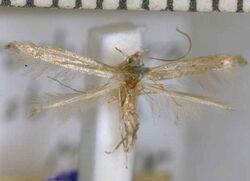Biology:Batrachedra tristicta
| Batrachedra tristicta | |
|---|---|

| |
| Female lectotype | |
| Scientific classification | |
| Domain: | Eukaryota |
| Kingdom: | Animalia |
| Phylum: | Arthropoda |
| Class: | Insecta |
| Order: | Lepidoptera |
| Family: | Batrachedridae |
| Genus: | Batrachedra |
| Species: | B. tristicta
|
| Binomial name | |
| Batrachedra tristicta Meyrick, 1901[1]
| |
| Synonyms[2] | |
| |
Batrachedra tristicta is a species of moth in the family Batrachedridae. It is endemic to New Zealand and has been found in both the North and South Islands. The larvae feel on the flowers and seed heads of rushes in the genus Juncus. The adults of this species are on the wing in March.
Taxonomy
This species was first described by Edward Meyrick in 1901 using material collected at Makatoku, in the Hawkes Bay, in March.[3] George Hudson discussed and illustrated this species both in his 1928 publication The Butterflies and Moths of New Zealand and his 1939 supplement to that work.[4][5] The lectotype specimen is held at the Natural History Museum, London.[2]
Description
Meyrick described B. tristicta as follows:
♂︎♀︎. 10-11 m.m. Head, antennae, thorax, abdomen, and legs fuscous-whitish. Palpi whitish, second joint with short scale-projection, subbasal and subapical spots of second joint, and basal and subapical spots of terminal dark fuscous. Fore wings whitish, irrorated with fuscous and sprinkled with dark fuscous ; first and second discal stigmata elongate, black, first somewhat before middle ; a round black apical dot : cilia very pale whitish-fuscous. Hind-wings grey ; cilia pale whitish-fuscous.[3]
Distribution
This species is endemic to New Zealand.[1][6] Along with the type locality in the Hawkes Bay, this species has also been collected in Fiordland.[5]
Biology and behaviour
The adults of this species are on the wing in March.[4]
Host species
The larvae feed on the flowers and seed heads of rushes, including wīwī (Juncus edgariae) and the introduced soft rush (Juncus effusus).[7][8][9]
References
- ↑ 1.0 1.1 "Batrachedra tristicta Meyrick, 1901". Landcare Research New Zealand Ltd. http://www.nzor.org.nz/names/eadb4328-555b-4472-a4a0-30dfd2e25f50.
- ↑ 2.0 2.1 Dugdale, J. S. (1988). "Lepidoptera - annotated catalogue, and keys to family-group taxa". Fauna of New Zealand 14: 1–264. ISBN 0-477-02518-8. ISSN 0111-5383. http://www.landcareresearch.co.nz/__data/assets/pdf_file/0003/49008/FNZ14Dugdale1988150.pdf. Retrieved 2017-01-20.
- ↑ 3.0 3.1 Meyrick, Edward (1901). "XVII. Descriptions of New Lepidoptera from New Zealand" (in en). Transactions of the Royal Entomological Society of London 49 (4): 565–580. doi:10.1111/j.1365-2311.1901.tb01373.x. ISSN 1365-2311. https://biodiversitylibrary.org/page/41672560.
- ↑ 4.0 4.1 Hudson, G. V. (1928). The Butterflies and Moths of New Zealand. Wellington: Ferguson & Osborn Ltd.. pp. 304. OCLC 25449322. http://www.bugz.org.nz/WebForms/ResultDetails.aspx?CurrentDoc=C7E94865-492F-45DA-9777-CC8E1E8B1438&back=true&NewDoc=true&searchType=1&SearchString=G.V.+Hudson.
- ↑ 5.0 5.1 Hudson, G. V. (1939). A supplement to the butterflies and moths of New Zealand.. Wellington: Ferguson & Osborn Ltd. pp. 442. OCLC 221041540. http://www.bugz.org.nz/WebForms/ResultDetails.aspx?CurrentDoc=4A102474-EF01-4089-A31A-A1FE7E551E52&back=true&NewDoc=true&searchType=1&SearchString=Hudson. Retrieved 9 June 2018.
- ↑ , p. 457, Wikidata Q45922947
- ↑ "PlantSynz - Invertebrate herbivore biodiversity assessment tool". https://plant-synz.landcareresearch.co.nz/ReportForm.aspx?RecordId=1465&Type=H&SortBy=Alpha&Biostatus=a,c,e,n.
- ↑ White, E.G. (1991). "The changing abundance of moths in a tussock grassland, 1962-1989, and 50- to 70-year trends.". New Zealand Journal of Ecology 15 (1): 5–22. https://newzealandecology.org/nzje/1891.pdf.
- ↑ Macfarlane, R. M.; Johns, P. M.; Patrick, B. H.; Vink, Cor J. (April 1998) (in en). Travis Marsh: invertebrate inventory and analysis.
Wikidata ☰ Q4869581 entry
 |



